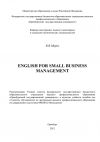Правообладателям!
Представленный фрагмент книги размещен по согласованию с распространителем легального контента ООО "ЛитРес" (не более 20% исходного текста). Если вы считаете, что размещение материала нарушает ваши или чьи-либо права, то сообщите нам об этом.Читателям!
Оплатили, но не знаете что делать дальше?
Текст бизнес-книги "Английский язык в экономике, бухучете и банковско-финансовой деятельности"
Автор книги: О. В. Иванов
Раздел: Жанр неизвестен
Возрастные ограничения: +12
Текущая страница: 2 (всего у книги 2 страниц)
Text 3. Economic growth
By «economic growth» economists mean, in the first place, annual increases in the nation’s total output of goods and services – its national product. Gross national product (gnp) does not take into account the wastage of the machinery and other capital goods used in production. Net national product (nnp) makes allowances for capital replacements. Although nnp includes final consumer goods and services, it counts only net additions to capital goods. It is therefore a better measure of real growth than gnp. The reason only final consumer goods are included is that care must be taken to avoid double counting; the output of bread is included, but the output of wheat used to produce the bread is not.
The monetary equivalent of national product – national income – can be measured in various ways. One is to measure it as the «value added» by economic activity in agriculture, manufacturing, mining, and so on. (Value added is calculated by summing output at producers’ prices and deducting the cost of the fuel and raw materials used to produce the output.) Another way is to measure it as the aggregate value of the final products of the economy. Still another is to total the incomes accruing to persons supplying different productive factors (such as wages and salaries, profits, rents). Each of these approaches yields the same total, provided a consistent scheme of valuation is used. The component detail of each, however, illuminates different facets of the process of production, distribution, and consumption of the nation’s output, and each serves a different use.
Changes in national income may be measured either in current prices – the prices that prevailed during the year in which the economic activity took place – or in constant prices – the prices of a given year, for example, those of 1929, which then serve as a base. In a study of financial developments or market trends the former is often preferable. But if the purpose is to analyze change in consumer levels of living or national productivity, the latter is more appropriate. For purposes of studying economic growth, therefore, it is constant price measurement that is desirable.
There are two additional requirements for the measurement of economic growth if the purpose is to calculate change in material welfare. A nation’s rate of growth must be divided by the size of its population in order to find the rate per capita; if an increased number of people is required to produce an increase in the amount of goods and services produced, no one is better off than before. On the other hand, high levels of both population and output growth, even without corresponding growth in per capita output, bespeak an economy’s ability to sustain large increases in population, and this is of interest to students of the sources of national influence and power. A final point: the increase in output should not be a temporary one, such as might follow a year of unusually good harvests. Nor should it merely represent an upward movement in the business cycle. Economic growth is sustained growth, secular in duration rather than cyclical.
In the output data of various countries scholars have found growth cycles (often called «long swings») of varying lengths, some of them 10 years long, others 60 years, and still others even 100 years. In the data of American history the most common long swing, named the «Kuznets cycle» after its discoverer, the Nobel Prize-winning economist Simon Kuznets, ranges between 10 and 20 years. A swing is a change in the rate of growth. During a long swing there occurs an expansion phase, followed by a period of continued growth at a retarded rate, culminating in depression. In the 124-year period between 1814 and 1938, nine long swings have been found, averaging 14 years in duration. In the expansion phase of these swings gnp grew at an average rate of about 6 percent, followed by retardation averaging 2 percent. During the depression phase, the rate of growth was extremely low or, ceasing altogether, negative.
Except for agriculture, the pace of growth of nearly every kind of economic activity registered advances during the expansion phase. Long swings occurred in the growth of population, labor force, immigration, transport development, internal migration, geographical settlement, urbanization, residential construction, the prices of common stocks, railroad bond yields, the money supply, commodity prices, and still other economic variables. Long swings, it should be emphasized, took place not in the total volume of output (which has risen without significant interruption, except for the 1930s, since the 1870s) but rather in the rate of increase of that total. Almost always, total output has risen, but at rates that accelerate and then decline. It is these alternations between acceleration and retardation that characterize the long swings of economic growth. America’s growth has proceeded in a series of great surges, followed by periods of much slower growth, and so has the growth of a number of other industrial countries.
Whether or not long swings characterized growth in the earlier years of the nation’s history seems impossible to know. Decennial census returns of output in the various sectors of the economy provide the most reliable source of information on which estimates of growth rates can be based and even these returns are incomplete before 1870. Not until 1840 did census takers include agriculture, which was then and for a number of decades afterward the main provider of incomes in the United States. Investigators of the quantitative records for the years before 1840 are compelled to work in the half-light of what has been called a «statistical dark age.» For the long colonial period (1607–1783) the light is even dimmer.
It is certain, however, that economic growth in the sense of increased population and output took place during the colonial years. From 105 colonists aboard the three small ships carrying English settlers to Virginia in 1607, the population grew to an estimated total of over 2 million by 1770, and by the time of the first federal census in 1790, it was nearly twice as large. Even if each person provided only enough food and clothing for his or her own subsistence, its imputed value would imply a huge expansion in total output. And available data on exports of tobacco and other commodities for a number of years in the eighteenth century enlarge that output even more. What historians do not know is whether or not growth per capita took place, and if so, by how much. Data on the size of houses and their furnishings in the later years, along with other supportive evidence, argue that the standard of living also rose. If so, and however slowly, growth in output per capita must also have occurred.
The quantitative remains of the early decades of independence are somewhat more satisfactory but still so fragmentary that conclusions about economic growth are little more than «guesstimates.» Making the most of the available evidence, Paul A. David posits the existence of three long swings between the 1790s and the Civil War. He finds in each a period of surge. In the first, the surge covers the years from the early 1790s to about 1806 and is associated with a large increase in the volume of foreign trade after the outbreak of the French Revolution and the Napoleonic Wars. In the second long swing the surge lasts from the early 1820s to about 1834 and is linked with early manufacturing development. In the third, identified with continuing industrialization, the surge commences in the latter half of the 1840s and runs its course before the firing on Fort Sumter. Although David believes that none of the surges involved a break in the secular growth rate, Robert E. Gallman is of the opinion that a «gradual acceleration took place over a very extended period of time.» Both scholars reject the hypothesis of W. W. Rostow that a dramatically abrupt transition from low to high rates of change, or «take off into self-sustained economic growth,» took place in the latter 1840s.
Viewing a longer segment of American history, from 1840 to 1960, Simon Kuznets has illuminated the phenomena of growth from a perspective that permits comparison with the records of a number of other countries. During that 120-year span the American population grew at an average annual rate of about 2.2 percent, gnp at 3.6 percent, output per capita at 1.6 percent, and product per worker at 1.4 percent. As a result of these growth rates, the population in 1960 was about 10.5 times as large as in 1840, the labor force almost 13 times, per capita product over 6 times, and product per worker over 5 times as large.
Surviving statistical data from the United Kingdom, France, Germany, Russia, and Japan range from 79 years for Japan to 117 years for the United Kingdom. The first result of a comparison between these countries and the United States is that the annual rate of growth of population in the latter was much higher than in any of the others. Compared with 2.2 percent in the United States, the rates of others ranged from 1.2 percent for Japan to 0.2 percent for France. Except for Japan alone, population growth rates in all the others were no more than half that of the United States.
Second, the annual rates of growth of product per capita for the United States and for the European countries were not greatly different. (The rates range from 1.9 percent for Russia, for a period reaching back to 1760, to 1.2 percent for the United Kingdom, back to 1841.) The American rate was 1.6 percent. The Japanese rate, for the period 1880–1960, was distinctly higher, 2.8 percent. Were data available to permit comparisons between the United States and these countries over the same length of time – all the way back to 1840—the averages for the other countries would be lower, including that of Japan. Finally, the rate of growth of gnp in the United States was higher than for the European countries, by amounts ranging from one-fifth to twice as high. This result naturally follows from the fact that the United States’ roughly equivalent rate of growth of per capita product was combined with a much higher rate of growth of population.
The American performance was exceptional. In his Essay on the Principle of Population (1798) Thomas Malthus offered a grim assessment of the consequences that would follow an increase in output. Population would respond by growing and would consume the additional output, reducing the level of living to what it had been before. The pressure of population on resources seemed relentless to Malthus, and he expected that war, pestilence, and starvation would provide the means of reducing it. American history offered testimony of a different kind: it was possible to have it both ways – more people and more resources, too. Technological advances would enable developed countries throughout the world to respond similarly to Malthus’s predictions.
In the closing decades of the twentieth century the American economy, as before, alternated between periods of expansion (for example, 1963–1968, 1976–1980, 1983-) and contraction (for example, 1969–1970, 1974–1975, and 1980–1982), without, however, sinking into a deep and prolonged depression like those of the 1870s and 1930s (although some of the contractions – now called recessions – were severe, for example, those of 1974–1975 and 1980–1982). Built-in stabilizers put in place by President Franklin D. Roosevelt’s New Deal in the 1930s – for example, old age and survivors’ and unemployment insurance – provided cushions during periods of falling demand. The uses of monetary and fiscal policies, too, were far better understood than before.
Nevertheless, the prospects of long-term economic growth are beset by problems far more grievous than those of earlier years. Although these problems are too numerous and complex for exploration here – they include a massive federal debt, large annual budget and trade deficits, and relatively low rates of domestic saving and investment in research and development – we can single out one because of the substantial effect it exerts on economic growth.
In recent years the rate of increase in manufacturing productivity – measured as output per unit of labor and capital combined – has been slowing down. From an annual average of 3.4 percent between 1948 and 1960 the rate fell to 2.3 percent from 1966 to 1973, to 1 percent from 1973 to 1977, and to 0.4 percent between 1977 and 1978. In 1979 and 1980 growth stopped altogether and productivity actually declined. Since then small recoveries have not overcome the long-term downward trend. The late nineteenth – and twentieth-century successor to Great Britain as the «workshop of the world,» the United States now finds its competitive edge dulled in the international marketplace while at the same time faced with intensified foreign competition at home. Indeed, by 1980 foreign-made goods were competing with more than 70 percent of those manufactured in the United States. Addressing this condition, and the budget and trade problems with which it is intimately connected, will be one of the great challenges of the 1990s and beyond.
Stuart Bruchey, The Roots of American Economic Growth: An Essay in Social Causation (1965); Simon Kuznets, Modern Economic Growth: Rate, Structure and Spread (1966); Simon Kuznets, Postwar Economic Growth: Four Lectures (1964).
Stuart Bruchey
EXERCISES
Exercise 1. Words and expressions. Provide Russian equivalents.
output of goods and services
per capita
Gross national product (gnp)
growth at a retarded rate
Net national product (nnp)
output per capita
double counting
product per capita
current prices
manufacturing productivity
constant prices
downward trend
material welfare
foreign-made goods
rate of growth
intimately connected
Exercise 2. Answer the following questions.
1. What do economists mean when speaking of «economic growth»? 2. What is national product? 3. What is the difference between GNP and NNP? 4. Is national income related to national product? 5. How do economists measure national income? 6. How can you describe growth cycles in a country’s output? 7. How are surges in economic growth explained? 8. What were Thomas Maltus’ views on the relationship between increase in output and population growth? 9. What problems influence prospects of economic growth in a country now? 10. What can be said about the rate of increase in manufacturing productivity in the U.S. in the late 1940s till 1980s?
Exercise 3. Translate into English.
1. Национальный доход – денежный эквивалент национального продукта – можно измерять несколькими способами. 2. Каждый из этих способов отражает различные стороны процесса производства, распределения и потребления продукции в государстве, и все они применяются для различных целей. 3. Изменения в национальном доходе можно измерять в постоянных либо в текущих ценах. 4. В целях исследования экономического роста желательно применять постоянные цены. 5. В расчетах экономического роста для определения изменений материального благосостояния необходимо учитывать два дополнительных требования. 6. Самые высокие темпы экономического роста на душу населения в странах Юго-Восточной Азии. 7. Рост производства не должен быть временным. 8. В данных о производстве продукции в различных странах ученые обнаружили циклы роста (часто называемые «долговременными колебаниями») меняющейся продолжительности, некоторые 10 лет, другие 60 лет, а некоторые даже 100 лет. 9. Колебание – это изменение темпов роста. 10. В фазе спада темпы роста чрезвычайно низкие или отрицательные. 11. В каждом из долговременных колебаний ученые обнаружили период подъема. 12. Следует подчеркнуть, что долговременные колебания имели место не в общем объеме производства (который рос без существенных перерывов), а скорее в темпах роста этого общего объема производства.
Внимание! Это ознакомительный фрагмент книги.
Если начало книги вам понравилось, то полную версию можно приобрести у нашего партнёра - распространителя легального контента ООО "ЛитРес".Правообладателям!
Представленный фрагмент книги размещен по согласованию с распространителем легального контента ООО "ЛитРес" (не более 20% исходного текста). Если вы считаете, что размещение материала нарушает ваши или чьи-либо права, то сообщите нам об этом.Читателям!
Оплатили, но не знаете что делать дальше?






